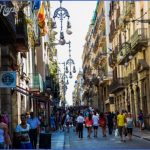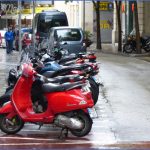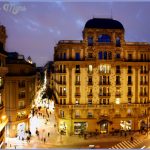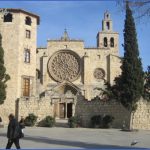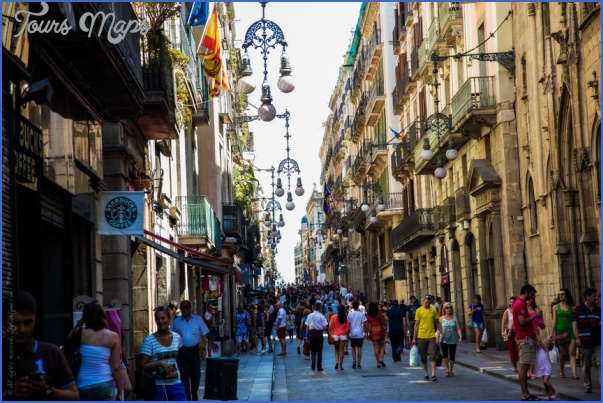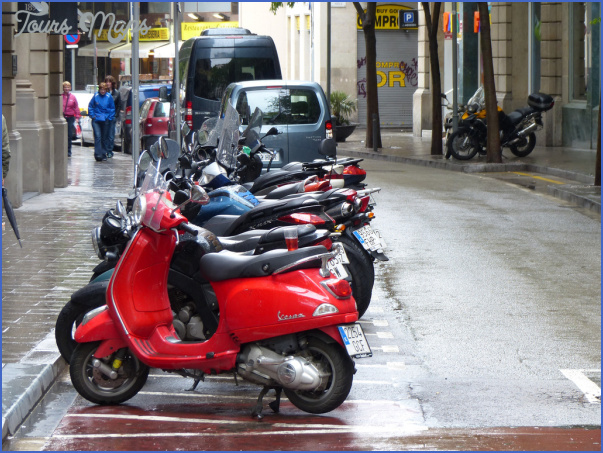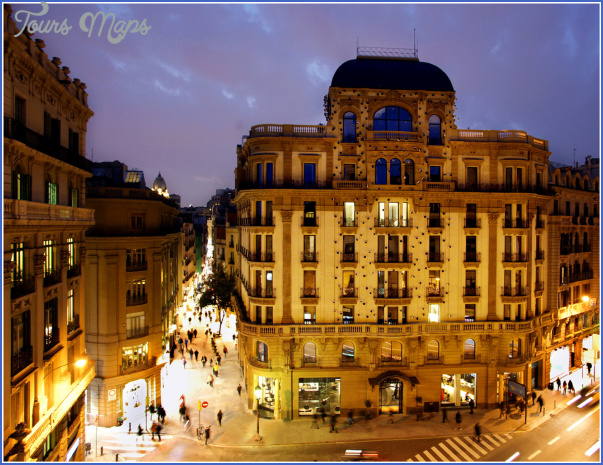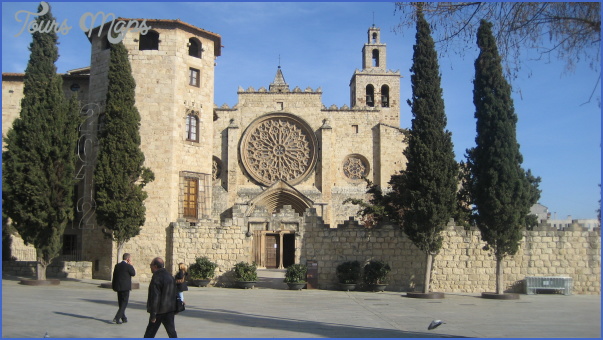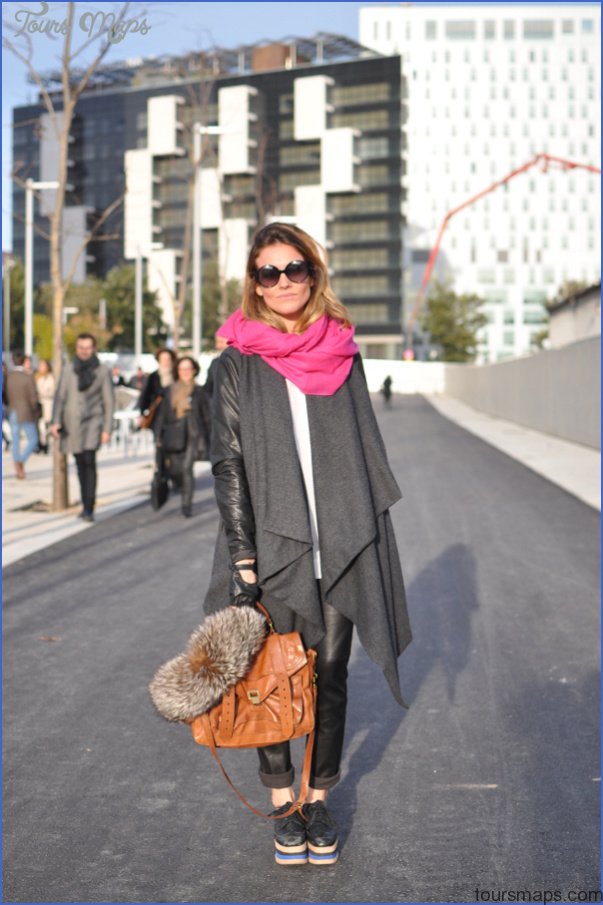Traveling in Barcelona
WATERFRONT
MUSEU MARITIM. The Drassanes Reiales de Barcelona (Royal Shipyards of Barcelona) are considered the world’s greatest standing example of Civil (i.e. non-religious) Gothic architecture and are currently awaiting nomination as a UNESCO World Heritage Site. The complex consists of a series of huge indoor bays with slender pillars, in which entire ships could be constructed and stored over the winter. Since 1941, the building has housed the Maritime Museum, which traces the evolution of shipbuilding and life on the high seas. (Av. Drassanes, off the rotary around the Monument a Colom. M: Drassanes, L3. s933 42 99 20. Open daily 10am-7pm. ‚5.40; under-16, students, and seniors ‚2.70.)
L’AQUARIUM DE BARCELONA. Barcelona’s aquarium the largest in Europe is an aquatic wonder, featuring a large number of octopi and penguins. The highlight is a 75m glass tunnel through an ocean tank of sharks and sting rays, as well as one two-dimensional fish. (Moll d’Espanya, next to Maremagnum. M: Drassanes. Open July-Aug. daily 9:30am-llpm; Sept.-June 9:30am-9pm. ‚13, students ‚12, under-12 and seniors ‚9.)
TORRE SAN SEBASTIA. One of the easiest and best ways to view the city is on these cable cars, which span the entire Port Veil, connecting beachy Barceloneta with mountainous Montjuic. The full ride, which takes about lOmin. each way and makes an intermediate stop at the Jaume I tower near Colom, gives an aerial perspective of the entire city. (Pg. Joan de Borbo. M: Barceloneta. In Port Veil, as you walk down Joan de Borbo and see the beaches to the left, stay right and look for the high tower. To Jaume I round-trip ‚7.50; to Montjuic one-way ‚7.50, round-trip ‚9.50. Open daily llam-8pm.)
VILA OLllVIPICA. The Vila Olimpica, beyond the east side of the zoo, was built to house 15,000 athletes and entertain millions of tourists for the 1992 Summer Olympics. It’s home to several public parks, a shopping center, and business offices. In the area called Barceloneta, beaches stretch out from the port. (M: CiutadellaVila Olimpica. Walk along the waterfront on Ronda Litoral toward the two towers.)
MONTJUIC
Throughout Barcelona’s history, whoever controlled Montjuic (Hill of the Jews) controlled the city. Dozens of rulers have modified the fortress, built atop an ancient Jewish cemetery; Franco made it one of his interrogation headquarters, rededicating it to the city in 1960. A huge stone monument expresses Barcelona’s (forced) gratitude for its return; the three statues symbolize the three seas surrounding Spain. (M: Espanya, then bus #50 (every lOmin.) from Av. Reina Maria Cristina.)
II FUNDACIO MIRO. Designed by Miro’s friend Josep Luis Sert and tucked into the side of Montjuic, the Fundacio links interior and exterior spaces with massive windows and outdoor patios. Skylights illuminate an extensive collection of statues and paintings from Miro’s career. His best-known pieces in the museum include El Carnival de Arlequin, La Masia, and L’or de L’azuz. Room 13 displays experimental work by young artists. The Fundacio also sponsors music and film festivals. (Av. Miramar 71-75. Take the funicular from M: Paral-lel. Open July-Aug. Tu-W and F-Sa 10am-8pm, Th 10am-9:30pm, Su 10am-2:30pm; Oct.-June Tu-W and F-Sa 10am-7pm, Th 10am-9:30pm, Su 10am-2:30pm. ‚7.20, students and seniors ‚4.)
II MUSEU NACIONAL D’ART DE CATALUNYA (PALAU NACIONAL). Designed by Enric Cata and Pedro Cendoya for the 1929 International Exposition, the beautiful Palau Nacional has housed the Museu Nacional d’Art de Catalunya (MNAC) since 1934. Its main hall is a public event space, while the wings are home to the world’s finest collection of Catalan Romanesque art and a wide variety of Gothic pieces. The Romanesque frescoes, now integrated as murals into dummy chapels, were salvaged in the 1920s from their original, less protected locations in northern Cataluna’s churches. The museum’s Gothic art corridor displays paintings on wood, the medium of choice during that period. The chronological tour of the galleries underlines the growing influence of Italy over Cataluna’s artistic development, and ends with a breathtaking series of paintings by Gothic master Bemat Martorell. Behind the building, the Fonts Luminoses (the Illuminated Fountains) are dominated by the central Font Magica, which are employed in weekend laser shows during the summer. (From M: Espanya, walk up Av. Reina Maria Cristina, away from the two brick towers, and take the escalators to the top. Open Su 10am-2:30pm, Tu-Sa 10am-7pm. ‚4.80; with temporary exhibits ‚6; temporary exhibits only ‚4.20. 30% discount for students and seniors.)
II CASTELL DE MONTJUIC. A visit to this historic fortress and its ESMuseum Mili-tar is a great way to get an overview of the city’s layout and history. From the castle’s exterior mirador, gaze over the city. Enjoy coffee at the cafe while cannons stare you down. (From M: ParaHel, take the funicular to Av. Miramar and then the Teleferic de Montju’ic cable car to the castle. Teleferic open M-Sa ll:15am-9pm. One-way ‚3.20, round-trip ‚4.50. Or, walk up the steep slope on C. Foe, next to the funicular station. Open Mar. 15-Nov. 15 9:30am-8pm; Nov. 16-Mar. 14 9:30am-5pm. Castle and mirador ‚1.)
ZONA ALTA
PARK GUELL. This fantastic park was designed entirely by Gaudf but in typical Gaudi fashion was not completed until after his death. Gaudf intended Park Giiell to be a garden city with dwarfish buildings and sparkling ceramic-mosaic stairways. Two mosaic staircases flank the park, leading to a towering Modernist pavilion that Gaudi originally designed as an open-air market. The longest park bench in the world, a multicolored serpentine wonder made of tile shards, decorates the top of the pavilion. In the midst of the park is the Casa-Museu Gaudi. (Bus #24 from PI. Catalunya stops at the upper entrance. Park free. Open May-Sept. daily 10am-9pm; Mar.-Apr. and Oct 10am-7pm; Nov.-Feb. 10am-6pm. Museum open daily Apr.-Sept. 10am-8pm; Oct.-Mar. 10am-6pm. ‚4, students ‚3.)
HMUSEU DEL FUTBOL CLUB BARCELONA. A close second to the Picasso Museum as Barcelona’s most-visited museum, the FCB museum merits all the attention it gets. Sports fans will appreciate the storied history of the team. The high point is the chance to enter the stadium and take in the enormity of Camp Nou. (C. Aristides Maillol, next to the stadium. M: Collblanc. Enter through access gates 7 or 9. Open M-Sa 10am-6:30pm, Su 10am-2pm. ‚5, under-13 ‚3.50.)
ENTERTAINMENT AND FESTIVALS
For tips on entertainment, nightlife, and food, pick up the Guia del Ocio (www.guiadelociobcn.es) at any newsstand. Most of Barcelona’s galleries are in La Ribera around C. Montcada. The best shopping in the city is on the posh Passeig de Gracia in 1’Eixample. Grab face paint to join Barga at the Nou Camp stadium for futbol. ( 934 96 36 00. Box office C. Aristedes Maillol 12-18.) Join in the Bsardana, Cataluna’s regional dance, in front of the cathedral after mass on Sundays (noon and 6:30pm). Bullfights are held at the Pla?a de Toros Monumental, on C. Castillejos 248. ( 932 45 58 04. Tickets ‚16-90.) Take advantage of Barceloneta or Poble Nou’s easy access to the Mediterranean. In addition to tons of sand for topless-tanning, there are plenty of places to rent sailboats and other water-sport equipment. Head up to Montju’ic and take advantage of the Olympic Facilities which are now open for public use, including Piscines Bernat Picornell, the gorgeous pool complex.
Outdoor activities in this bustling cosmopolitan city are not exactly abundant. However, the Parc de Collserola in Zona Alta has hiking, biking, and horseback riding. (932 80 35 52. Open daily 9:30am-3pm.) Also, the Catalan Pyrenees and Islas Baleares are easily accessible from the city.
Festivals in Barcelona, as in the rest of Spain, occur often; if you are in the city for more than a week, chances are that some sort of celebration will be happening. Remember to double check sight and museum hours during festival times as well as during the Christmas season and during Semana Santa (Holy Week; the week before Easter). The Festa de Sant Jordi (St. George; Apr. 24) celebrates Cataluna’s patron saint with a feast. Men give women roses, and women give men books. On August 15-21, city folk jam at Gracia’s Festa Mayor; lights blaze in plagas and music plays all night. The Sonar music festival comes to town in mid-June, attracting renowned DJs and electronic: enthusiasts from all over the world for three days of concerts and partying. The Festa de Musica (July 1), a city-wide celebration of music, comes soon afterward, during which free concerts are held all over Barcelona. During July and August the Grec Festival hosts dance and concert performances, as well as film screenings, in different concert venues. On September 11th, the Fiesta Nacional de Catalufia is celebrated with traditional costumes, dancing, and Catalan flags hanging from balconies.
Traveling in Barcelona Photo Gallery
Maybe You Like Them Too
- Explore Pulau Sebang Malaysia with this Detailed Map
- Explore Southgate, Michigan with this detailed map
- Explore Les Accates, France with this Detailed Map
- Explore Góra Kalwaria, Poland with this detailed map
- Explore Gumdag, Turkmenistan with this detailed map

